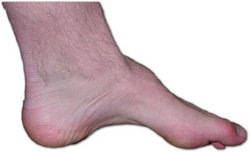Charcot-Marie-Tooth disease
Charcot-Marie-Tooth disease, also known as Hereditary Motor and Sensory Neuropathy (HMSN) or Peroneal Muscular Atrophy, is an inherited disorder of nerves (neuropathy) that is characterized by loss of muscle tissue and touch sensation, predominantly in the feet and legs but also in the hands and arms in the advanced stages of disease. The disease is presently incurable. more...
The disorder is caused by the absence of molecules that are essential for normal function of the nerves due to deficiencies in the structure of the genes coding these molecules. The absence of these chemical substances gives rise to dysfunction either in the axon or the myelin sheath of the nerve cell.
The disease is named for those who classically described it: Jean-Martin Charcot (1825-1893) and his pupil Pierre Marie (1853-1940) ("Sur une forme particulière d'atrophie musculaire progressive, souvent familiale débutant par les pieds et les jambes et atteignant plus tard les mains", Revue médicale, Paris, 1886; 6: 97-138.), and Howard Henry Tooth (1856-1925) ("The peroneal type of progressive muscular atrophy", dissertation, London, 1886.)
Symptoms
Symptoms usually begin in late-childhood or early adulthood. Usually, the initial symptom is foot drop due to involvement of the peroneal nerve, which is responsible for raising the feet, early in the course of the disease. This can also cause hammer toe, where the toes are always curled. Wasting of muscle tissue of the lower parts of the legs may give rise to "stork leg" appearance. Symptoms and progression of the disease can vary. Extreme emotional stress is thought to hasten the progression.
Diagnosis
The diagnosis is established by electromyography examination (which shows that the velocity of nerve impulse conduction is decreased and the time required to charge the nerve is increased) and nerve biopsy. Genetic markers have been identified for some, but not all forms of the disease.
Types of the disease
CMT Type 1 (CMT1)
Type 1 affects approximately 80% of CMT patients and is the most common type of CMT. The subtypes share clinical symptoms. Autosomal dominant. Causes demyelination, which can be detected by measuring nerve conduction velocities.
- CMT type 1A - CMT1A (OMIM 118220) - The most common form of the disease, caused by mutations in the PMP22 gene (locus 17p11.2). 70-80% of Type 1 patients. Average NCV: 15-20m/s
- CMT type 1B - CMT1B (OMIM 118200) - Caused by mutations in the MPZ gene (1q22) producing protein zero (P0). 5-10% of Type 1 patients. Average NCV: <20m/s
- CMT type 1C - CMT1C - Sometimes called Dejerine-Sottas disease - Causes severe demyelination, which can be detected by measuring nerve conduction velocities. Autosomal dominant. Usually shows up in infancy. LITAF Gene (16p13.1-p12.3) Average NCV: 26-42m/s. Identical symptoms to CMT-1A.
- CMT type 1D - CMD1D - EGR2 Gene (10q21.1-q22.1) - Average NCV: 15-20m/s
Read more at Wikipedia.org



